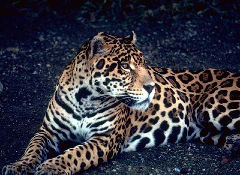Jaguar
 Jaguar: Panthera onca
Jaguar: Panthera onca
Distribution: Central and South America, from Northern Mexico to Patagonia.
Habitat: Jungle and scrubland to shoreland forests and reed thickets.
Size: Height : 68-76cm,
Weight: male 57-113kg Female 46-91kg
Life-span: Up to 22 years in captivity.
Food: Mice, tapir, deer and other forest animals, fish, caimans, and domestic animals.
Sexual maturity: 3 years.
Mating season: Any time in the tropics, early Autumn elsewhere.
Gestation: 70 days. Litter size: 2-4 kittens.
Territory: Jaguars are largely solitary. Young jaguars spend the first few years with their mother, and adult jaguars stay together for a brief time during the breeding season. Territory size depends on the availability of food. In an undisturbed area with plenty of wildlife, a jaguar may only need about 5 square kilometres. In areas where forests have been cleared, a jaguar may need up to 500 square kilometres of territory to feed itself adequately.
Daily life: The jaguar hunts at night. It can climb trees, and occasionally drops down on its prey, but usually it hunts on the ground, relying on stealth rather than stamina, as it does not like to chase its prey far. Kills may range from mice to deer, though dogs, cattle and sheep will also be considered, especially in cleared areas. Jaguars can also catch fish.
Breeding: Little is known about wild jaguars, because they are so rare. It appears that the male and female meet only to mate. When mating is over, the male returns to his territory and the female brings up the one to four young on her own. The cubs are blind and weigh less than 1kg each. By six months, the cubs accompany their mother on hunting trips. By three years of age the jaguar is sexually mature.
Jaguars are still common in the upper basin of the Orinoco river in Venezuela, but the The IUCN lists the Jaguar overall as 'near threatened', with perhaps no more than 200 remaining in the whole of Argentina. In the 1960s, hunters shot more than 1,000 Brazilian jaguars every year. Fur hunting, along with loss of habitat to farming are the greatest threats to the jaguar's survival. Hope may come from zoos though, as jaguars breed successfully in captivity.
Although thought of as 'man-eaters', jaguars are more likely to escort intruders off their territory, and many people tell tales of men being followed through the forest by a shadowy jaguar. Amazon Indians claim that jaguars sometimes emerge from the forest to play with children.
Read More: Credits